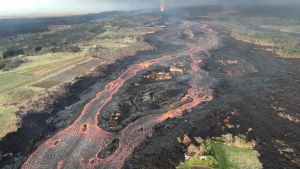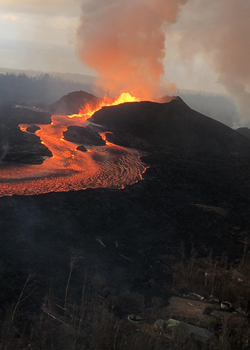High-Risk Lava Zones With Infrequent Eruptions Attract Development
The unprecedented cost of the 2018 Kiīlauea eruption in Hawaiʻi reflects the intersection of distinct physical and social phenomena: infrequent, highly destructive eruptions and atypically high population growth, according to a new study published in Nature Communications and led by University of Hawaiʻi at Mānoa researchers
 Fissure 8 erupts in lava hazard zone 1, May 5, 2018. (Photo credit: Bruce Houghton) It has long been recognized that areas in Puna, Hawaiʻi, are at high risk from lava flows. In fact, Puna lies within the three highest-risk lava hazard zones (1, 2 and 3). This ensured that land values were lower, which actively promoted rapid population growth.
Fissure 8 erupts in lava hazard zone 1, May 5, 2018. (Photo credit: Bruce Houghton) It has long been recognized that areas in Puna, Hawaiʻi, are at high risk from lava flows. In fact, Puna lies within the three highest-risk lava hazard zones (1, 2 and 3). This ensured that land values were lower, which actively promoted rapid population growth.
- Read more about UH’s research on the 2018 Kiīlauea eruption.
 Houses surrounded by lava. Roads now lead to nowhere. Fissure 8 fountain. (Photo credit: Bruce Houghton)
Houses surrounded by lava. Roads now lead to nowhere. Fissure 8 fountain. (Photo credit: Bruce Houghton)
 In lava hazard zone 1 a cone is formed and a lava river flows to zone 2. (Photo credit: Bruce Houghton)
In lava hazard zone 1 a cone is formed and a lava river flows to zone 2. (Photo credit: Bruce Houghton)
Kīlauea is one of the most active volcanoes on Earth and has one of the earliest, most comprehensive volcanic monitoring systems. Its recent history has been dominated by activity at the summit caldera and from one of two lines of vents called the Eastern Rift Zone. Between 1967 and 2018, volcanic activity was dominated by eruptions from the upper part of the Eastern Rift Zone. In contrast, no damaging eruptions occurred after 1961 in the more heavily populated Puna district from the vents within the lower portion of the Eastern Rift Zone.
Assessing trends
The UH team assessed trends in population growth in Pāhoa-Kalapana, Hilo and Puna using census data, and compared the median cost of land and household income in these areas.
Valuable lessons regarding the complex interplay of science, policy and public behavior emerged from the 2018 disaster.
“Steep population growth occurred during the absence of any locally sourced eruptions between 1961 and 2018, and set the scene for the unprecedented levels of infrastructural damage during the 2018 Lower Eastern Rift Zone eruption,” said Wendy Cockshell, co-author on the paper and technical assistant at the National Disaster Preparedness Training Center (NDPTC) at UH Mānoa.
If population growth resumes in lava hazard zones 1 and 2, there will be increased risk in the most dangerous areas on this exceptionally active volcano translating into high cost of damage in future eruptions.
“Our funded research supports the principle of the initiatives by local and federal government to provide buy-out funding to landowners affected by the 2018 eruption to enable them to relocate outside of these hazardous areas,” said Houghton.
The study was funded with support from the National Science Foundation and the NDPTC.
This effort is an example of UH Mānoa’s goal of Excellence in Research: Advancing the Research and Creative Work Enterprise (PDF), one of four goals identified in the 2015–25 Strategic Plan (PDF), updated in December 2020.
–By Marcie Grabowski
Publication: Houghton, B.F., Cockshell, W.A., Gregg, C.E. et al. Land, lava, and disaster create a social dilemma after the 2018 eruption of Kīlauea volcano. Nature Communications, (2023). DOI:10.1038/s41467-021-21455-2
Original Story Source: University of Hawaii at Manoa

 Alerts Sign-up
Alerts Sign-up